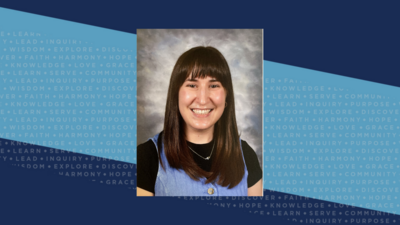Center for Liturgical Art Conserves 12 Reinhold Marxhausen Mosaics

The Center for Liturgical Art (CLA) at Concordia University, Nebraska recently received 12 mosaics chiefly created by former professor of art Reinhold Marxhausen from St. John Lutheran Church in Forest Park, Illinois. The church, located just ten miles outside of downtown Chicago, recently closed their associated school, where these mosaics resided for nearly six decades. In July 2023, CLA staff transported the mosaics from Illinois to Concordia Nebraska.
Emeritus professor of art William Wolfram, as well as a third artist, assisted Marxhausen in the creation of the mosaics in 1964, following a commission from the church that, at the time, was preparing to open its school. Each of the 12 mosaics depicts one of Jesus’ disciples, and a final one entitled “The Great Catch of Fish” is in the church’s narthex and illustrates Jesus’ calling of His disciples. St. John faculty placed one disciple’s mosaic in each kindergarten through eighth grade classroom, as well as confirmation rooms and the school’s library.
According to current Concordia art professor, James Bockelman, the mosaics featured Venetian and Byzantium-style tiles as well as additional materials such as glass, pebbles, metal pieces, and clay tiles. He added that Marxhausen wanted each mosaic to be unique, just like each of Jesus’ disciples.
“In order to portray the ideas, thoughts, and concepts of the original disciples, the following order would be used to determine which words or visual symbols would be used [in the mosaics]: first, the words that the disciples spoke to Jesus; second, words that have been attributed to the disciples, and third, if no words, then a scene that depicted either their work or ministry,” said Bockelman.
Before the creation of the mosaics, the church in Forest Park also wrote a statement of purpose for the pieces, making sure that they would accomplish theological goals in addition to their artistic ones. “The mosaics should be decorative – and they should teach,” was one point that the document, now contained in Concordia’s archives, made.
“Jesus said much to the disciples, which is pertinent to all disciples of Him,” was another point made in the statement, adding a layer of theological explanation to Bockelman’s description of how the words in each mosaic were chosen.
Upon their arrival at Concordia, the mosaics required some age-related repairs. CLA Interim Director Michael Scheer, along with several student employees, eagerly accepted the task.
“Since I am a studio art major, being able to be a part of the restoration process and learning from Marxhausen’s style has been very beneficial to my art education,” said junior Hannah Helmer, one of the CLA’s employees. “The process is rewarding but also has its challenges.”
Helmer explained that, due to the age of the mosaics, pieces that fell off were hard to color-match with new replacement tiles. “Thankfully at the CLA we have access to a lot of the original tiles that Marxhausen used so we can accurately restore the missing pieces,” she said.
The mosaics were on display in Concordia’s Marxhausen Gallery of Art through December 13, 2023. According to CLA Staff, “after the conclusion of the show [in Marxhausen Gallery] the mosaics will be moved to a permanent location” somewhere on Concordia’s campus.
Information on the mosaics from St. John Lutheran Church is available on the church’s website. Restoration of the mosaics “will likely take the rest of the calendar year to complete,” Scheer said in late 2023. Afterward, they will move to their more permanent home.
Interested in the history of Concordia’s Center for Liturgical Art? Learn more here.


